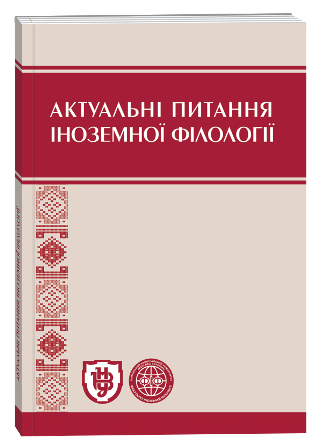PARAVERBAL COMMUNICATION MEANS (BASED ON THE GERMAN LANGUAGE)
Keywords:
communication, verbal means, non-verbal, means, paraverbal means, verbalization, phonation, handuritingAbstract
The article analyses paraverbal means of communication, delineates the differences between paraverbal and non-verbal means and the connection between them. Paraverbal means of communication are those which can manifest themselves through language (oral and written speech), i.e., the strength or power of the voice, its timber, the tempo of speech, distinctness/clarity of sound, peculiarities of articulation, intonation, the length of pauses etc; indispensable graphic characteristics: handwriting, density of lines, spacing between words or letters, punctuation, dominating means of singling out components of the communicative structure of a sentence (the topic and the comment), etc. Paralinguistic means not only complement the content of speech communication, but they are also a source of information about a person, his or her social and age features, character, etc. For the analysis of verbalization of oral speech we have used the text of the play Mother Courage and Her Children by Bertold Brecht. Based on the analysis of 75 lexical units denoting paraverbal means we have singled out four lexical unit groups, namely: lexemes verbalizing the loudness of the voice; lexemes verbalizing the acoustic properties of the voice; lexemes rendering emotions and attitudes of the characters by means of the voice; and lexemes used by the author to render “casual” sounding of the voice. By “casual” we mean remarks accompanied by the character’s additional actions which affect the sound of the voice. Paraverbal communication means also include the figuration of written speech. The article analyses a handwritten poem. Peculiarities of handwriting, such as the pressure of the pen on the paper, the line consistency, the linking of the letters in the words, the slant of the handwriting, the size of the letters, the roundedness of the letters, the signature, the spacing between the words and the lines, etc., point to different physical, mental and emotional characteristics of a person.
References
Андреева Г. М. Социальная психология / Г. М. Андреева. – М. : Аспект Пресс, 2004. – 366 с.
Бацевич Ф. Вступ до лінгвістичної прагматики / Ф. Бацевич. – К. : Академія, 2011. – 302 с.
Бацевич Ф. С. Основи комунікативної лінгвістики : підручник / Ф. С. Бацевич. – К. : Академія, 2004. – 344 с.
Застровська С. О. Вербалізація парамовних та немовних засобів комунікації (на матеріалі німецької мови) / С. О. Застровська // Вісник Київ. нац. лінгв. ун-ту. Сер. «Філологія». – 2010. – № 2. – С. 64–69.
Застровська С. О. Термінологічна поліфонія у дослідженнях з комунікативної лінгвістики / С. О. Застровська // Актуальні проблеми іноземної філології: лінгвістика та літературознавство : міжвуз. зб. наук. пр. – Бердянськ : БДПУ, 2011. – С. 105–111.
Ковалевська Т. Ю. Комунікативні аспекти нейролінгвістичного програмування : монографія / Т. Ю. Ковалевська. – О. : Астропринт, 2001. – 344 с.
Косенко Ю. В. Роль невербальних засобів комунікації в дискурсі прощання / Ю. В. Косенко // Вісник Сум. держ. ун-ту. Сер. «Філологічні науки», 2005. – Вип. 6. – С. 23–31.
Костецкая А. Г. Голос, интонация, манера речи студентов Гарвардского университета в Романе Эрика Сигала «The Class» / А. Г. Костецкая // Языковая личность: проблемы лингвокультурологии и функциональной семантики : сб. науч. тр. – Волгоград : Перемена, 1999. – С. 118–127.
Крейдлин Г. Е. Невербальная семиотика: Язык тела и естественный язык / Г. Е. Крейдлин. – М. : Новое лит. обозрение, 2002. – 581 с.
Проблемы коммуникативной лингвистики / редкол. : Б. А. Ольховиков и др. – М. : [б. и.], 1982. – 192 с.
Серякова И. И. Лексико-семaнтические и коммуникативно-функциональные особенности языковых единиц, описывающих невербальное средство коммуникации «голос» в современном английском языке : дис. … канд. филол. наук : 10.02.04 / Ирина Ивановна Серякова ; Киев. нац. лингвист. ун-т. – К. : [б. и.], 1987. – 182 с.
Серякова И. И. Прагматические характеристики языковых единиц, описывающих невербальное средство коммуникации «голос» / И. И. Серякова // Высказывание и дискурс в прагмалингвистическом аспекте : сб. науч. тр. – К. : КГПИИЯ, 1999. – С. 83–85.
Якименко Н. Невербальні засоби ділового спілкування / Н. Якименко // Дивослово. – 2003. – № 5. – С. 42–45. 14. Brecht B. Mutter Courage und ihre Kinder / Bertolt Brecht. – Berlin : Erstdruck Suhrkamp, 1980. – 112 S.








